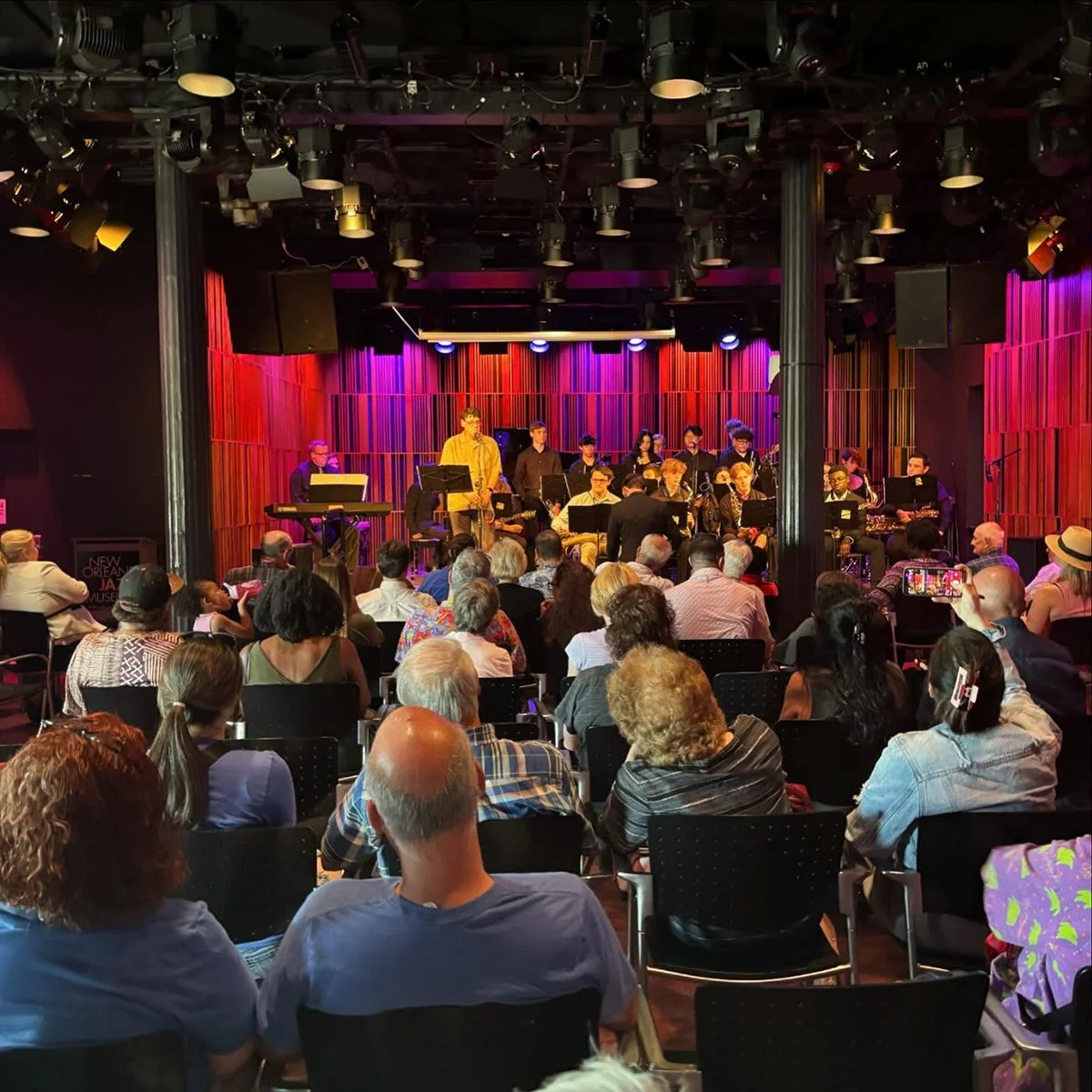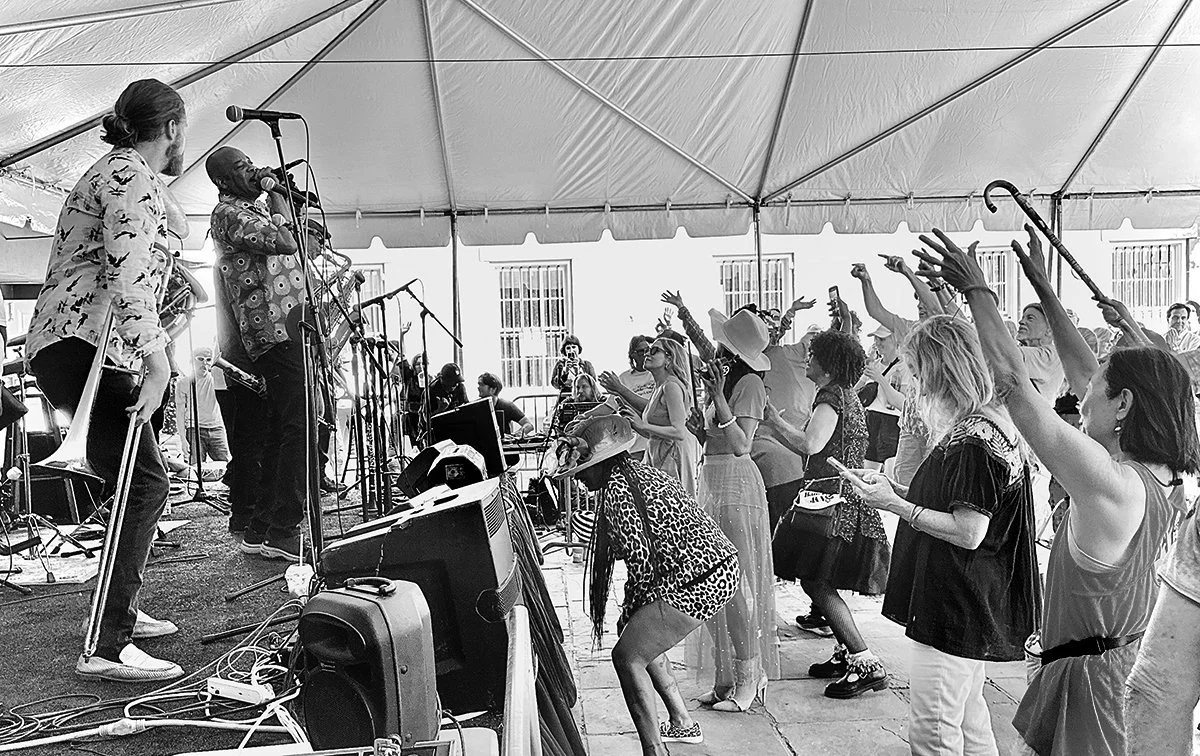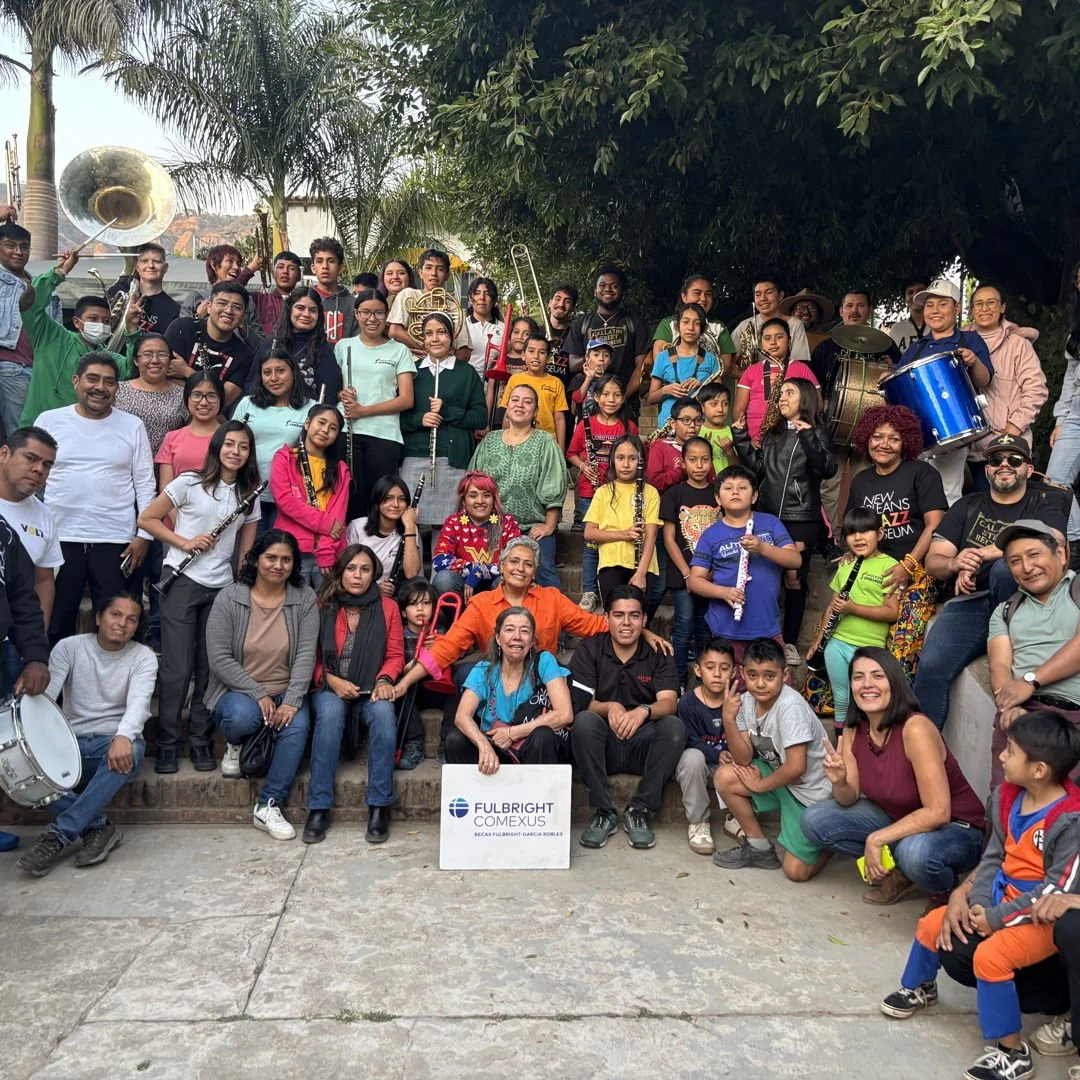On the New Orleans Jazz Museum Beat
Trumpeter James Andrews and band performs in the Jazz Museum for the opening reception of a new “Satchmo” exhibit, August 2024. Andrews is one of the local musicians working with Gallatin Street Records, a project of the Jazz Museum. Photo by Ellis Anderson
June 2025From its recently revamped Performance Center to its musician-promoting record label, everything is up-tempo on Esplanade Avenue.
– by Doug Brantley
This column is underwritten in part by Lucy Burnett
“It’s a lot,” says New Orleans Jazz Museum director Greg Lambousy, paging through the eight-year-old institution’s thick annual report.
Part of that “a lot” is the museum’s third-floor Jazz Performance Center - it consistently draws standing-room-only crowds for its free Tuesday-Friday concerts.
In early March, the Jazz Museum welcomed music lovers back to the space following a $1.2 million upgrade. The Performance Center features new floors and chairs, along with five PTZ remote-controlled cameras and a 17-foot retractable screen.
Acclaimed architect and acoustician John Storyk (who designed Jimi Hendrix’s Electric Lady Studios) of the Walters-Storyk Design Group was commissioned to lead the redesign, adding more sound baffling and a much-welcome, dedicated front-of-house engineering position that now melds seamlessly with the rest of the room.
In early March, the museum celebrated the revamped Performance Center space, with Louisiana Lt. Gov. Billy Nungesser cutting the ribbon. Photo courtesy Jazz Museum
Travis Waguespack, AV Engineer and Danny Kadar, Chief Production Engineers for the Jazz Museum at the upgraded front of house board in the Performance Center. Photo Ellis Anderson
The control room received a major makeover as well. The once-cramped space was gutted to the walls, its doors relocated, a new isolation booth constructed and outfitted with a state-of-the-art Dolby Atmos surround sound system.
Danny Kadar, in the newly reimagined control room with mixing, mastering and Dolby Atmos surround system. Photo Ellis Anderson
And there’s more to come in the months and years ahead. Much more.
“Now, we’re moving our sights to the Education Center,” says Lambousy. That’s also being reimagined by Storyk’s award-winning WSDG team. When it’s complete, Lambousy says it will be “an education center that happens to have a world-class recording studio.”
Add a year-round outdoor stage on the Jazz Museum’s French Market-facing side, a music-minded sculpture garden, a café, an expanded permanent exhibit on the history of jazz, its broadening Jazz International outreach project, growing Gallatin Street Records label – and it is indeed “a lot.” Especially at a time when other museums are seeing their funding stripped away.
But while the sculpture garden and other envisioned landscaping elements are part of a federal Economic Development Administration grant, Lambousy points out, there isn’t a constant stream of federal funding. Nor is the museum’s programming dependent on state financing.
One of four stages that the Jazz Museum hosts during French Quarter Festival, 2025. photo courtesy the New Orleans Jazz Museum.
“I’ve been with the State Museum for 30 years,” he says, “gaining experience in areas such as collections management, exhibition development, and music programming. When they asked me to develop the Jazz Museum, I said, ‘The only way I’m interested is if it’s a public/private partnership,’ knowing that state budgets can fluctuate.
“The enthusiasm of Lt Governor Billy Nungesser for this public/private venture allowed us to create a quality music museum for the people of Louisiana – and our world audience.”
The Performance Center and Education Center improvements, for example, were made possible by a matching grant from the Herb Alpert Foundation. The Ruth U. Fertel Foundation provided capital for the initial build-out of the Ed Center’s Jazz Lab, while the Jay Pritzker Foundation funded the museum’s Don Marquis Reading Room.
International Jazz Day 2024,
A promotion for one of the museum’s weekly balcony concerts, sponsored by Positive Vibrations Foundation
“We have our long-range plans,” says Lambousy, “but also deal with whatever the situation is at the time.”
Of course, the thread that connects all these projects is music. And there’s beaucoup of that as well.
On top of its popular weekly Balcony performances and Gallatin Street Fridays concert series, in April the museum hosted the 42nd annual French Quarter Festival and the second iteration of the Gallatin Street Fest. The latter is organized in-house, strategically scheduled on Monday between Jazz Fest weekends. This year, it drew more than 1,100 attendees.
“We came up with the idea as a way to showcase our artists and for people from out of town to learn more about the label,” explains Gallatin Street Records vice president Ewa Blecharczyk. “It’s part of the bigger mission of promoting the artists, which is what we are here for.”
Poster for the 2025 Gallatin Street Fest
James Andrews and the other Gallatin Street artists wowed enthusiastic crowds at the 2025 Gallatin Street Fest. See FQJ’s full album of photographs from the event.
Gallatin Street artist, jazz guitarist Detroit Brooks, backstage with Jazz Museum director Greg Lambousy at the 2025 Gallatin Street Fest, photo by Ellis Anderson
In June, Gallatin Street will release its latest LP, Next Generation Jazz Band of New Orleans: Passing the Torch, Volume 1. The band is made up of local student musicians who come together to learn and perform traditional New Orleans music and big band music. It’s under the leadership of director Jeremy Williams, who brought legendary trumpeter Wendell Brunious and others on board to mentor and perform with the youth.
“From the beginning, the Gallatin Street Records project has been about wanting to support younger musicians,” Lambousy notes, “as well as elder musicians who are doing good stuff but haven’t had a chance to record.”
The Roots of Music band, crowd-pleasers who perform at the Jazz Museum each year, opening the Satchmo Fest in August. photo by Ellis Anderson
A 1953 illustration by Wiley Sylvester Churchhill, courtesy the Historic New Orleans Collection, 1974.25.15.112
Established in 2011 – the same year the Performance Center opened and long before the museum itself was established – Gallatin grew out of an effort to digitize a huge reel-to-reel collection of archival traditional jazz recordings that had been gifted to the State Museum by the New Orleans Jazz Club.
“These vintage recordings, mostly from the 1940s and ’50s, were just sitting in a vault and not being heard,” says Lambousy. “They provide a snapshot in time of many great musicians – the first two generations of jazz artists who have since passed.”
Meanwhile, the Performance Center was amassing an impressive collection of its own, with a great number of current-day local musicians playing and recording live sessions at the venue.
So why not combine the two to form, what Lambousy calls, one “significant archive of New Orleans music” and make it available to the public?
The new project took its name from a notoriously sketchy, two-block stretch of bars and brothels abutting the Old U.S. Mint (now the Jazz Museum). The strip was a hive of activity from the mid-1800s until the 1930s, when the buildings on the riverside of the blocks were razed and the street was renamed French Market Place.
Gallatin Street Records operates as a small, boutique label, with a limited pressing of 500 or so LPs for each recording.
“The label isn’t about making money,” Lambousy notes, “it’s founded on what museums are about – or should be all about: Access to information and heritage. In this case, music.”
To date, the label counts 27 releases, starting with 2014’s Bon Bon Vivant: Live at the New Orleans Jazz Museum. Other recordings have featured collaborations with Bo Dollis, Jr., Generic Art Solutions, the Rebel Babel Ensemble, the George Brown Band, Mahmoud Chouki, and the District VI Honor Band. Talks are underway on an upcoming James Andrews project.
Ewa Blecharczyk, Greg Lambousy, and Katie Katzenmeyer at New Orleans Record Press in 2024 with the new Caravan album by Mahmoud Chouki, photo courtesy Jazz Museum.
Gallatin Street artists pay no recording, production, or pressing fees, and their contracts are non-exclusive, meaning they can take their recordings to another label, as long as they credit the museum and its engineers.
“The idea is to be a nonprofit record label that acts as a vehicle for artists to not only fundraise, but provide an infrastructure for them to succeed,” says Blecharczyk. “That means supporting them from start to finish, whether it’s recording their music, promoting it, or helping them find performance opportunities.”
Gallatin Street Records digital media strategist Baylee Badaway and Vice President Ewa Blecharczyk at the Money Jukebox in the Jazz Museum – which is housed in the former New Orleans Branch Mint. The jukebox is filled with money-themed songs, an exhibition created by Generic Art Solutions.
Gallatin Street artists also collaborate with members of the ELLA Project, a pro bono legal and advocacy group for musicians and cultural nonprofits, which is housed in the museum. The ELLA Project advises on contracts, copyrighting, and navigating the business end of things.
“A lot of artists don’t always know what resources are available to them,” Blecharczyk continues. “We want to be a trusted place they can turn to – a hub that connects them to opportunities and helps them grow. Take someone like George Brown. We were able to get him to Paris, introduce him to international collaborators, and that opened the door for his touring career to really take off.”
This year, the breakout trombonist, who got his start with the Roots of Music and the Hot 8 Brass Band, will be performing in multiple cities around the world, as well as representing the Jazz Museum during the Festival Interceltique de Lorient in Brittany, France, from August 1st to 10th, joined by trumpeter Chantz Powell.
George Brown, now a two-time Grammy-nominated artist, says that Gallatin Street Records has played a pivotal role in broadening his career.
“The label championed my artistry by organizing a cultural exchange mission that took me to France,” he says, “expanding my international presence and influence. They also captured the essence of my live performance by recording my first album at the New Orleans Jazz Museum, preserving the authenticity of my sound in a historic setting.”
George Brown on Gallatin Street, photo by Ellis Anderson
Brown also noted that Gallatin Street Records secured a spotlight performance for him at the Jazz Museum’s annual Improvisations Gala. “That further elevated my profile in the music industry,” he says, “and solidified my reputation as a global ambassador of New Orleans funk.”
Brown and Powell aren’t the only local musicians traveling abroad this summer.
Several New Orleans musicians will accompany Moroccan-born Gallatin Street artist Mahmoud Chouki to Casablanca from June 9 to 15 for CasaNOLA. It’s a new festival that the museum is helping develop as part of its Jazz International outreach.
And at the end of June, Darryl Montana, Dianne Honoré, and Victor Campbell will participate in the Grand Piano Festival in Orléans, France.
The poster for the new CasaNOLA festival in Casablanca, June 9 - 15, 2025
Then in September, the Jazz Museum’s third annual, three-day Festival Jazz Nouvelle-Orleans à la Goutte d'Or – developed in partnership with Le 360 Paris Music Factory – is on tap.
Drummer Joe Lastie and members of Cha Wa will serve as the city’s cultural ambassadors, in addition to James Andrews, who has participated in the event since its inception. Later in the year, Andrews will also travel to Taiwan with the museum’s international team.
“What we do at the Jazz Museum really bridges two worlds. We’re sharing New Orleans music and culture with people around the globe, while creating real opportunities for local musicians right here at home,” says Lambousy.
“It’s about honoring where jazz comes from and making sure it keeps growing – with New Orleans at the center of it all.”
The museum’s Jazz Ambassadors, led by Douglas Stone, Director of the LSU Jazz Ensemble, recently embarked on a powerful cultural exchange mission to Cuernavaca and Tepoztlán, Mexico. Photo courtesy Jazz Museum
A group photo from the museum’s cultural exchange mission in partnership with Fulbright Comexus to Cuernavaca and Tepoztlán, Mexico. Photo courtesy Jazz Museum
The Jazz International team and New Orleans musicians in 2023 on the rooftop of Le Paris 360 Music Factory. Taslya Mejia, international relations manager for the Jazz Museum, third from left. Taslya has dynamically led the Museum’s international programming. Photo courtesy Jazz Museum
A second-line during the Jazz Museum’s 2024 three-day Festival Jazz Nouvelle-Orleans à la Goutte d'Or – developed in partnership with Le 360 Paris Music Factory. Photo courtesy Jazz Museum


























